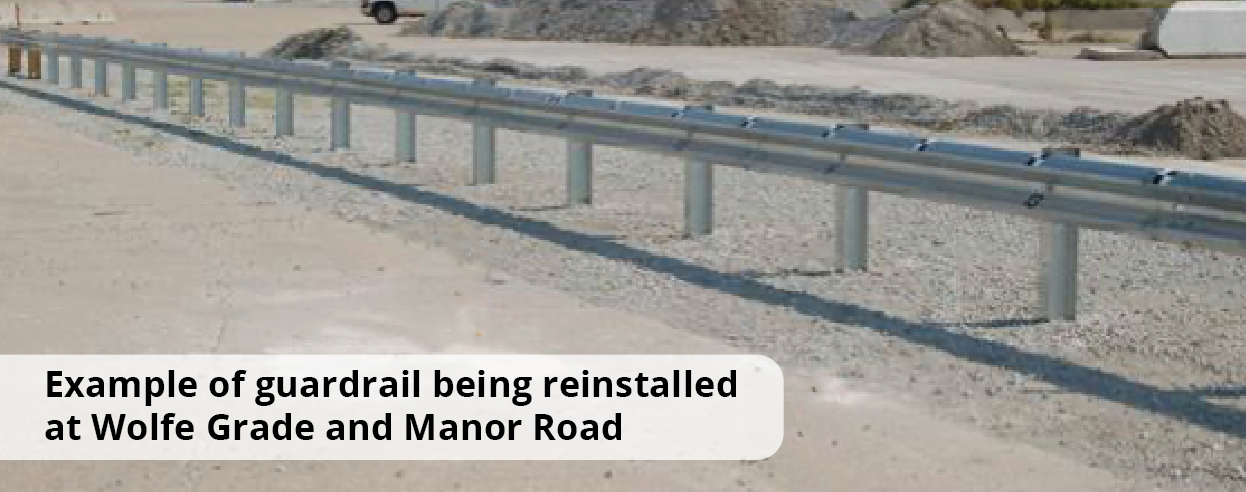
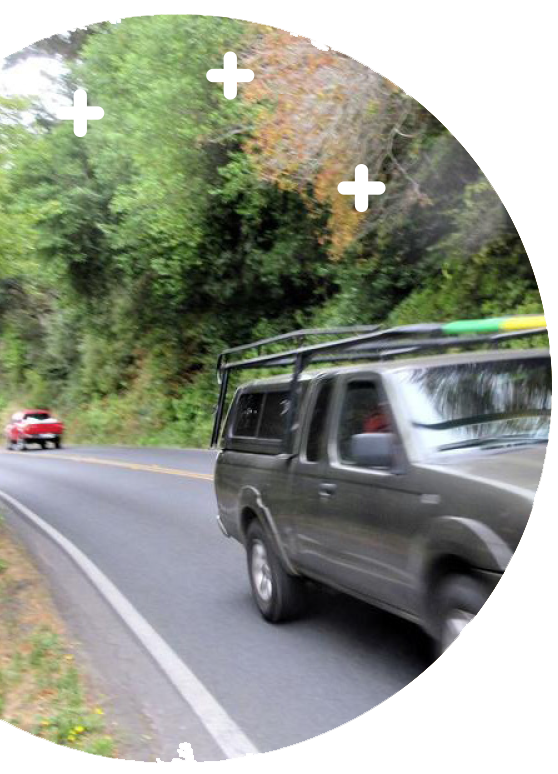

General Project Information
Street Lighting
Traffic Signals
Medians and Landscaping
 Slip Lanes
Slip Lanes
 Guardrails & Fencing
Guardrails & Fencing
GENERAL PROJECT INFORMATION
What is Upgrade the Drake?
Upgrade the Drake is a County of Marin project which will rehabilitate 2.2 miles of Sir Francis Drake Boulevard between Highway 101 and the Ross town limit, an 18-month project that will include many safety enhancements. Sir Francis Drake Boulevard is a major east-west corridor located in Marin County, and connects community members to key destinations and activity centers. Construction began in June 2020 and, dependent upon weather and other potential delays, is anticipated to be completed by December 2021.
What improvements will be included?
In addition to repaving, the project consists of pedestrian safety improvements, striping, intersection and signal improvements, traffic operation improvements, utility infrastructure improvements, and new street lighting.
What are the project construction costs? How is this project being funded?
Upgrade the Drake is estimated to cost a total of approximately $18 million. The Transportation Authority of Marin (TAM) allocated $14.5 million for the project from its Major Roads Project Fund. Those funds come from the Measure A transportation sales tax, which passed in 2004. Marin County staff secured approximately $3,465,000 from other stakeholders including the County Service Area 17 (Kentfield-Greenbrae-Larkspur), the Marin County Street Light Fund, and various grants. The Marin Municipal Water District agreed to reimburse the County for the base bid amount of $3 million for replacement of their pipeline as well all other associated costs.
Will Sir Francis Drake Boulevard close at any point during construction?
There are no anticipated full closures of Sir Francis Drake Boulevard during construction. However, the construction team expects partial lane closures and traffic delays throughout the process.
Can I expect traffic delays during construction?
Yes, the project team anticipates there will be traffic impacts during construction. The County thanks the community for their understanding, and suggests travelers plan their trips through the project area ahead of time.
Will the project include night work?
The project includes nighttime work to minimize disruptions to peak traffic flow times along the corridor. Daytime work is also being done as well to reduce nighttime noise disturbance in nearby neighborhoods.
How can I stay updated about the project and construction activities that may impact me?
The project team will be updating this website on a weekly basis with traffic and construction updates. You can also sign up to receive e-mail updates here or call the project hotline with any questions (415-688-7613). Project team members will respond to all inquiries within 24-hours.
STREET LIGHTING
The following definitions are provided to differentiate between “Street lights” and “Traffic Signals”:
Street lights are poles that hold lighting devices to illuminate roadways, intersections and pathways.
Traffic signals are poles with attached signaling devices positioned at road intersections, pedestrian crossings, and other locations which control the flow of traffic.
What changes are proposed to the Street Lights on Sir Francis Drake Boulevard?
Lighting poles and fixtures will be replaced along about one third of the corridor with shorter, decorative poles and fixtures. The shorter poles would require closer spacing to sufficiently and uniformly light the roadway, resulting in a net increase in total street lights. To reduce additional cost, the placement of these decorative poles would reuse light foundations already installed to the extent possible. The remaining light fixtures on the other two thirds of the project corridor, excluding intersection lighting, would be replaced with different fixtures that are dimmer and cast less light outside of the roadway and sidewalks. In addition, backlight shields would be installed on all sidewalk light poles to further minimize light spill into neighboring yards.
When will the Street Light changes be installed?
Safety light fixtures will be replaced at the eight (8) signalized intersections beginning in November 2021. The Lighting project will be bid during the winter 21/22 with construction proposed to begin in spring/summer 2022. The estimated lead time for ordering new poles is 6 months.
Why aren’t more of the poles being replaced with decorative poles?
The pole replacements are only occurring in median locations where a number of new poles were added. In areas where there were existing street light poles in the pre-project condition, only the fixture head will be replaced.
Why was lighting a safety concern for Sir Francis Drake Boulevard?
Sir Francis Drake Boulevard through the project zone has been a historically low-light corridor, and improving visibility for all users was discussed in regards to sidewalk path widening. Improving lighting will significantly lower the risk of vehicular collisions, and provide for a safer experience for pedestrians using the walkway on the north side of the road. Collision data collected over years, including collisions at night and those involving vulnerable road users, were used to help define the safety needs for this project.
How was the design of the initial lighting system determined?
The County of Marin worked with street lighting consultants to help define the required height, location and spacing to meet safety standards for lighting. The consultant analyzed the existing lighting conditions in the project area and compared potential improvements within the project to industry lighting standards along a roadway of this type which were summarized in a Lighting Assessment Memorandum.
Among the roadway characteristics factored in the lighting design were the permitted speed limit of 35 miles per hour, the average daily traffic, and the multiple user groups within the community, including students, residents, shopping center patrons, multi-use path users and public transportation. The average daily traffic of Sir Francis Drake Boulevard ranges significantly, going from 46,000 vehicles per day near the Bon Air Center to 22,000 vehicles per day at the Ross Town limit. The lighting guidance for safety needs provided location and brightness recommendations throughout the several distinct regions of the 2.2 mile corridor, applying needs-based lighting solutions for each section.
Was this lighting system included in the EIR?
The project scope did not include modifications to the streetlight system. After the Final EIR was certified and during the final design of the project, it was determined that improvements to the street lighting were needed to improve safety. Under CEQA, the improvements proposed qualified for a categorical exemption and therefore further CEQA review was not required. The County filed the Notice of Exemption on May 7, 2020.
What happened with the initial streetlighting upgrades that were turned on in February 2021?
The new streetlighting on Sir Francis Drake Boulevard, which was installed along the median from El Portal to Eliseo Drive, was turned on the night of February 3, 2021. This was the first time the new median lights were illuminated and the resulting lighting effect was not as intended. The County of Marin recognized the undesirable effect of this lighting and would like to apologize for the inconvenience. For an immediate short-term fix, this new streetlighting along the median near the Bon Air Center will be turned off until a long-term lighting solution can be found. County staff are working to find a long-term solution that maintains the safety goals of the corridor while reducing concerns raised by residents along the corridor. Previously installed new lighting at the intersections will remain active for safety reasons. Future potential solutions will be shared with the community as they are developed.
Who is the new lighting consultant?
The County selected the consulting firm, Fehr & Peers, who recently completed a community-driven lighting project in Marin County, working hand-in-hand with community leaders, stakeholders, and the County, to provide a context-sensitive solution resulting from a thorough community engagement process.
Did the lighting plan take into account that there’s already a lot of existing light coming from Bon Air Center?
The previous lighting analysis and design did not account for light coming from the Bon Air Center. Our new lighting consultant has measured the ambient light from Bon Air Center to incorporate those findings into the photometric model. The model will also analyze light dispersal from project lighting onto adjacent properties.
Will quality of light be considered?
The appearance of the light as measured in color temperature (measured in degrees of Kelvin) will be reviewed along with the pattern of light dispersal from the fixture heads. The height, size, and spacing of the streetlight poles will be among other lighting system components reviewed with the lighting assessment.
Is there more or less traffic at night? How does this impact lighting along Sir Francis Drake Boulevard?
Although there is less motorized traffic at night, studies have shown that up to 50% of collisions involving fatalities occur at night. The nighttime fatal accident rate on unlighted roadways is about three times the daytime rate. Lack of, or insufficient, roadway lighting is a significant factor contributing to vehicular collisions at night.
Do the paths along Sir Francis Drake Boulevard stay lit at night?
Lighting levels for paths will be further analyzed based on surveys of the number of pedestrians using walkways during the first hour of darkness. When the days are shorter in the months of December and January, there are more pedestrians on the paths at dawn and dusk.
What’s the cost going to be? Can the light poles be repurposed?
Over 75% of the cost of the lighting is for underground lighting infrastructure that will remain in place including foundations and wiring. If poles are replaced, it is anticipated that they can be returned and/or reused since they are standard poles. Additional cost for changes will be determined when alternatives are identified.
Lighting is especially disturbing for those that live near intersections. Will these lights be reviewed?
We will analyze the effects of light shields on streetlights at intersections to determine if they can address lighting concerns while still maintaining industry requirements for lighting levels at intersections. Safety lighting is an important element at intersections where there is pedestrian activity.
TRAFFIC SIGNALS
The following definitions are provided to differentiate between “Street lights” and “Traffic Signals”:
Street lights are poles that hold lighting devices to illuminate roadways, intersections and pathways.
Traffic signals are poles with attached signaling devices positioned at road intersections, pedestrian crossings, and other locations which control the flow of traffic.
Are the new traffic signal poles larger than the previous poles?
Yes. There are several reasons the new traffic signal poles are larger than the previous poles:
1. The new traffic signal poles where designed based on the 2018 Caltrans Standards which are the relevant standards for cities and counties in California. The new standards are based on a 100MPH wind speed as opposed to 80MPH. Going forward these larger and stronger poles will become more common place across the state as the older equipment is replaced.
2. With the intersection reconfigurations, the signal poles are no longer placed on medians and therefore need to suspend signal equipment farther out over the roadway. The need for intersection reconfigurations including new traffic signal poles was addressed in the project’s EIR.
3. The original signal mast arms have fewer attachments (generally one or two signal heads) attached to the mast arm. The new signal mast arms will have more attachments (up to three or four signal heads) to also accommodate signal heads for left turning vehicles, signs, etc.
4. The new poles are designed to accommodate changes to attached equipment (more heads, additional signs, etc.) so that minor adjustments of signal equipment attached to the mast arms would not require a brand-new signal pole in the near future. This is a long term cost savings improvement.
MEDIANS & LANDSCAPING
When will the landscaping of the medians be completed?
The median landscaping is on hold due to the ongoing drought. Marin Municipal Water District has declared a water shortage emergency and adopted mandatory water use restrictions. The new planting will be installed when the drought is over and the water usage restrictions for irrigation have been lifted. We appreciate your patience as we all do our part to conserve water at this time.
What kind of plants are going to be planted in medians along the corridor?
A variety of plants and trees will be used as part of the Upgrade the Drake’s landscaping plan. These range from formal style plantings to naturalistic garden style. For more details, please see the Planting Palette.
SLIP LANES
Why are slip lanes being removed as part of the Upgrade the Drake project’s safety improvements?
Traffic and pedestrian safety standards are constantly changing and improving based on data and research. Over 40 years ago, slip lanes were installed at intersections on Sir Francis Drake Boulevard (SFD) in accordance with the standards of the time. However, modern design practice has moved away from slip lanes, and the associated “pork chop” pedestrian islands, for roadways such as SFD. The slip lanes were removed from SFD for the following reasons:
• Typically slip lanes do not have a dedicated pedestrian signal (with countdown) or a traffic signal requiring motorist to come to a stop prior to the pedestrians crossing.
• Pedestrians cross slip lanes to “pork chop” islands which have limited space for pedestrians. This limited space is particularly problematic at the Laurel Grove intersection of SFD with high pedestrian traffic near the schools, as shown in the photo.
• Slip lanes are a “double crossing” where pedestrians are in the roadway (exposed to vehicular traffic) for a longer duration. Eliminating slip lanes by bulbing out the curbs shortens the overall distance that pedestrians walk in the roadway.
• The traffic signal poles on pork chop islands have experienced a higher incident rate of being struck by motorists than traffic signal poles on corners of conventional intersections.
• Vehicles tend to drive too fast through slip lanes. It is important for pedestrian safety that vehicles slow down when turning at intersections, particularly on to residential streets such as La Cuesta and Laurel Grove Avenue.
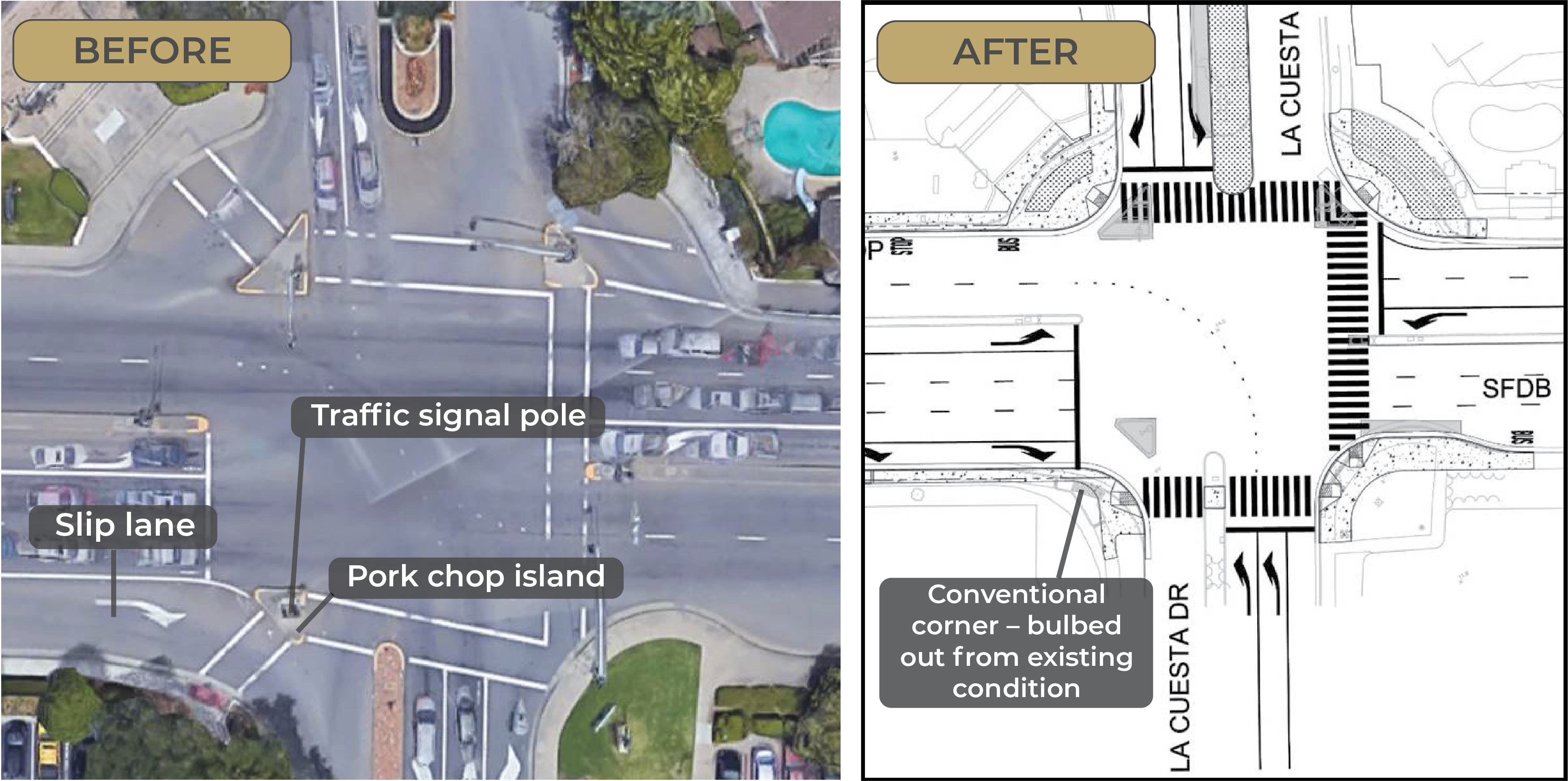
Will right-turn lanes be changed?
Despite removing the slip lanes and pork chop islands, all of the intersections in the project corridor are retaining their dedicated right-turn lanes for right-turning traffic. Drivers will continue making turns in a separate lane from through traffic while maintaining vehicle flow through the intersection.
GUARDRAILS & FENCING
Why is the metal guard rail being replaced by post and cable fencing?
In the late 1960s, the County installed metal guardrails along one mile of Sir Francis Drake Boulevard, between Wolfe Grade and Eliseo Drive. As part of the 2020 Upgrade the Drake project, the County and project team reviewed existing conditions along the 2.2-mile stretch of the corridor. Based upon current safety standards, the County determined the guardrail was unnecessary except for a segment between Wolfe Grade and Manor Road where the guardrail will remain in place.
Post and Cable Fencing Upgrades
The existing guardrail along Sir Francis Drake Boulevard has been replaced with a 44-inch tall post and cable fence, with the exception of the segment mentioned above. By removing the guardrail along Sir Francis Drake Boulevard, the County can install new fencing 18-inches away from the curb to provide an additional buffer between motorists and pedestrians/bicyclists.
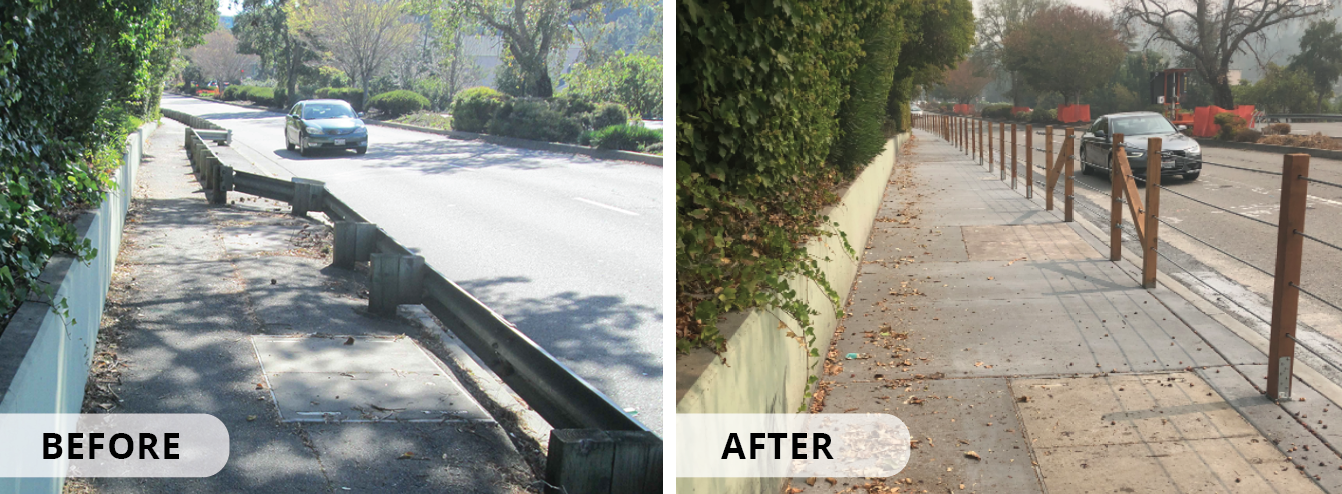
The new fencing is taller than the guardrail, which will prevent pedestrians and bicyclists – particularly children – from falling into the roadway. Additionally, this improvement allows for wider sidewalks throughout the corridor, making it easier for those walking and biking to travel. A comparable post and cable fencing is located on Camino Alto near Mill Valley Middle School, in the City of Mill Valley.
Along with the new fencing, the County will also stripe a six-inch wide fog line at the edge of vehicle lanes. Fog lines at the edge of the travel lanes clearly mark the separation between travel lanes and shoulder areas.
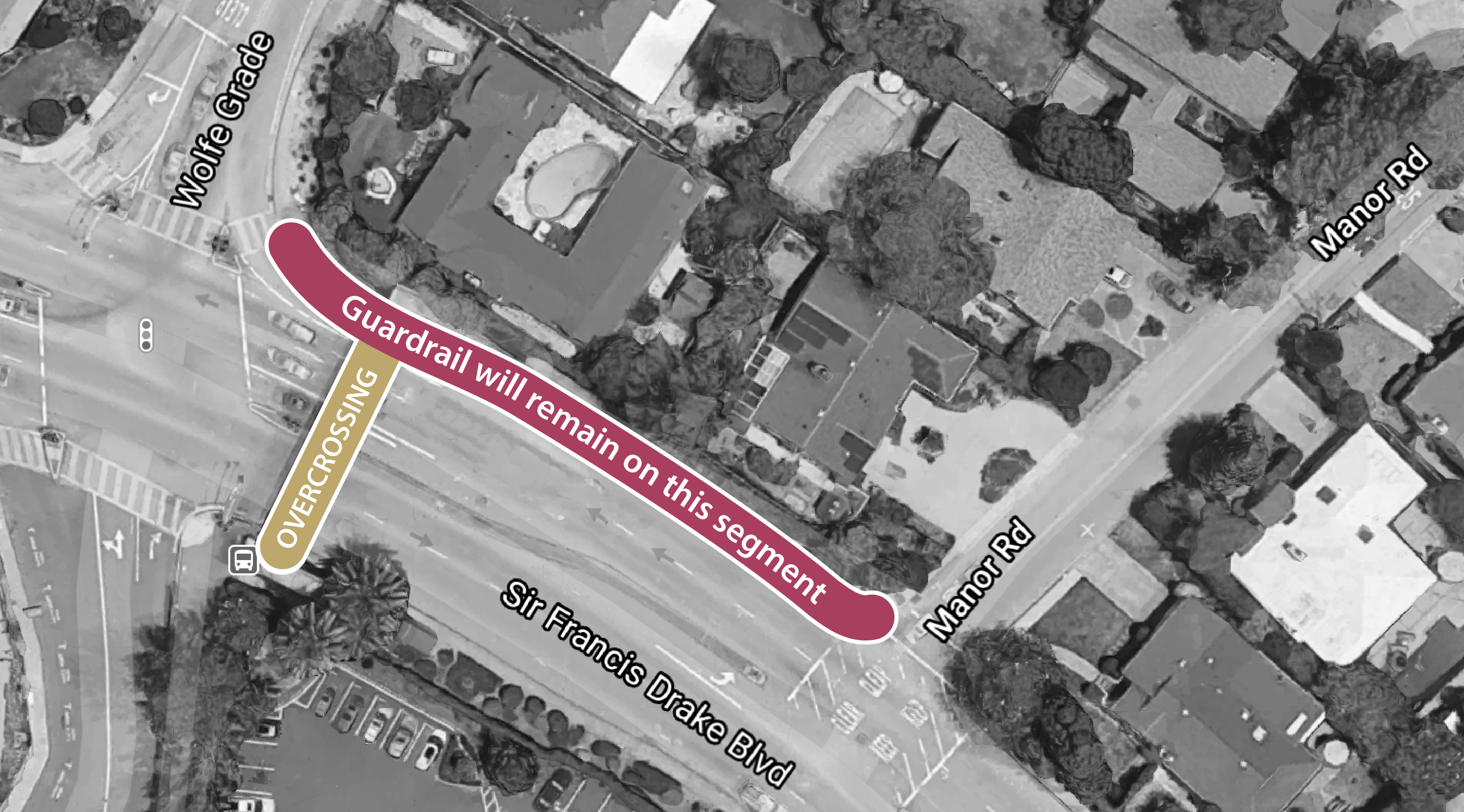
Guardrail Segment Between Wolfe Grade and Manor Road
Guardrails are installed on roadways when there is a large, fixed object that vehicles could potentially hit. The pedestrian overcrossing at this location of Sir Francis Drake Boulevard is an example of a fixed object; the guardrail in front of it protects drivers from running into the overcrossing’s concrete column. Given those facts, the section of guardrail will remain for the following other reasons: the pedestrian overcrossing regularly serves high levels of foot traffic; there is a history of vehicle crashes at this location; there is a curve in the road between Wolfe Grade and Manor Road; and there is a lack of shoulder at the right turn lane onto Wolfe Grade.
